Assessing Outdoor Air Near Schools
North Birmingham Elementary School - Birmingham, AL
- Understanding the Monitoring Data
- Initial Sample Results
- Initial Analysis
- Additional Sample Results
- Final Analysis
Initial Analysis of EPA’s monitoring
EPA selected North Birmingham Elementary School, along with Riggins School and Lewis Elementary School in Birmingham, AL, for monitoring because these schools are located near two coke plants, an electric arc furnace, and a chemical distribution company which are sources of air toxics emissions. Computer models were used to determine which air toxics may be present at elevated levels in the outdoor air near these schools. These models showed that lead and pollutants associated with coke plant operations, including benzene, arsenic, and benzo(a)pyrene, could be present in the air around the schools and prompted EPA to test to see if the levels present may be of concern.
| Primary Findings | At all three schools, levels of lead, a pollutant for which there are national standards for ambient air, are below the level of the national standard for protection of public health. Our analysis also found that levels of a number of pollutants, some of which are associated with coke plant emissions, including benzene, arsenic, and benzo(a)pyrene, indicate a potential for levels of concern for long-term continuous exposure particularly in areas of the community close to the source of emissions. Levels of manganese in the air at Lewis Elementary School indicate a potential for levels of concern for long-term continuous exposure in areas closer to the source. The elevated level of manganese, while not indicating a level of concern for health effects at this location, indicates a potential for levels of concern in areas closer to the source. Levels of manganese in the air at the two other schools were below levels of concern. |
| Key Pollutants Monitored | Lead. Inhalation and ingestion may affect the developing nervous system if people are exposed to high levels. |
| Next Steps | Based on the analysis described here, EPA plans to conduct additional monitoring in several locations to better characterize the potential for exposures of concern in the community. EPA will also conduct additional monitoring at Lewis Elementary School to better define the potential impact of manganese emissions on the community. EPA remains concerned about emissions from sources of air toxics and continues to work to reduce those emissions across the country, through national rules and by providing information and suggestions to assist with reductions in local areas. The Jefferson County Department of Health (JCDH) will continue to oversee industrial facilities in the area through air permits and other programs. |
Summary of Study Approach and Findings
Approach:
- A series of monitors collected air samples from August 5, 2009 through December 3, 2009, at Riggins School, North Birmingham Elementary School, and Lewis Elementary School in Birmingham, AL.
- We posted individual air sample results on the websites for these schools (Riggins School, North Birmingham Elementary School, and Lewis Elementary School) throughout the monitoring period to keep your community informed during the monitoring period.
- During the monitoring period, we evaluated the monitored concentrations to see if there was a concern from short-term exposures (e.g., up to several weeks exposure duration).
- When the monitoring was complete, we analyzed the results to see if there was a concern from long-term exposures (over a lifetime).
- Also, when the monitoring was complete, we evaluated all the air samples from the on-site monitors.
- We also evaluated information on wind speed and wind direction collected by a weather monitor at each of the schools, along with historical weather information and information about nearby sources of lead, benzene, arsenic, benzo(a)pyrene, and manganese emissions.
Findings:
- Our analysis found that at all three schools, levels of lead, a pollutant for which there are national standards for ambient air, are below the level of the national standard for protection of public health.
- Our analysis found that levels of pollutants associated with coke plant emissions, including benzene, arsenic, and benzo(a)pyrene, in the air indicate a potential for levels of concern for long-term continuous exposure particularly in areas of the community closer to the sources of these pollutants.
- Our analysis found that levels of manganese in the air at Lewis Elementary School indicate a potential for levels of concern for long-term continuous exposure. Additional monitoring will be conducted to better define the potential impact of manganese emissions on the community.
- The concentrations of lead measured at each of the schools are lower than those suggested by the information that helped identify these schools for monitoring.
- The process to identify schools for monitoring relied on emissions estimates and other information. Ambient air monitoring at the school allowed measurement of what was actually in the air.
- Information from the nearby coke plants indicates that they were operating below normal production levels (approximately 60%of the production levels of a year earlier and a year later). However, it should be noted that pollutant emissions are not necessarily related to production levels at these coke plants. There are several sources of lead in the area two of which have closed or not emitting lead. During monitoring the electric arc furnace was operating at about half normal production levels, and another source of lead was operating about 20% below typical levels in 2009. It was determined that the chemical distribution facility only distributed chemicals and did not produce them.
- EPA recommends additional monitoring in several locations to better characterize the potential for exposures of concern in the community from the pollutants associated with coke plant emissions. EPA also recommends additional monitoring at Lewis Elementary School to better define the potential impact of manganese emissions on the community.
- Click here for additional information
How We Analyzed the Information We Collected at this School
The analysis considered whether the information collected at these schools might raise concerns for the health of children or adults at these schools. We looked at the following types of information:
- Measured lead, benzene, arsenic, benzo(a)pyrene, and manganeseconcentrations and information on lead, benzene, arsenic, benzo(a)pyrene, and manganese
- Measured wind direction and wind speed at these schools
- Information about nearby sources of lead, benzene, arsenic, benzo(a)pyrene, and manganese emissions
Analysis of Measured Lead Concentrations:
1. Calculate the average: We calculated the averages of the lead (TSP) measurements for each of the 3-month periods in which monitoring occurred (the higher of these averages is shown by the black diamond in the graph below). We compared this average to the long-term comparison level (thick line on the graph below). The comparison level is the level of the national ambient air quality standards (NAAQS) for lead, which is in terms of a 3-month average.
Result: The average lead level for the samples collected was well below the comparison level. The health concern is low.
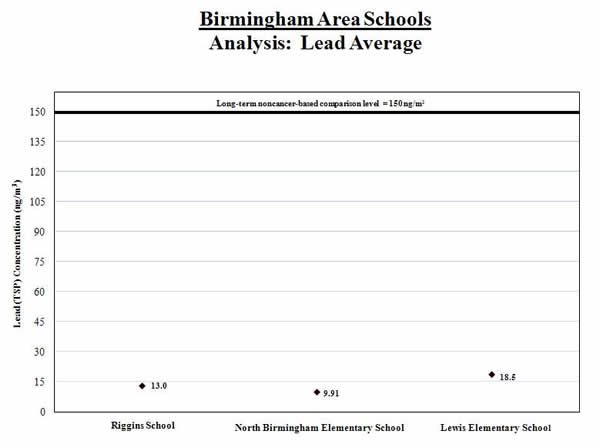
2. Calculate a range: To account for varying air concentrations of lead, we calculated a range around the average by estimating high and low average values that the longer-term concentrations might reach using common statistical tools (the higher of these ranges is presented in the graph below). We compared the highest point in the range (called the “upper bound”) to the comparison level.
Result: The high end of the range is much lower than the comparison level. The health concern is low.
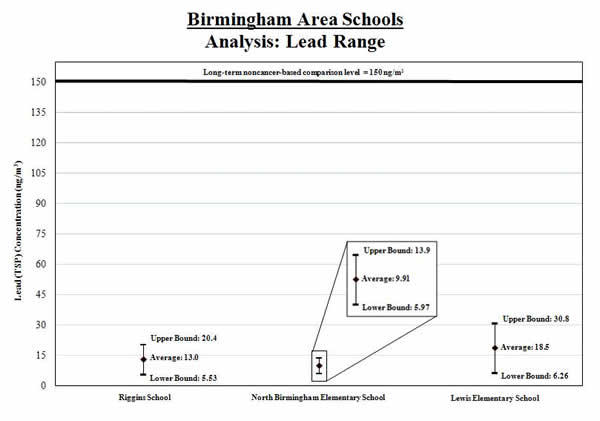
Analysis of Measured Concentrations of Pollutants Associated with Coke Plants:
Although the concentrations of arsenic and benzo(a)pyrene, are individually below long-term comparison levels (as shown below), the benzene concentrations and long-term concentrations of some other source-related pollutants are near their long-term comparison levels. The complete analyses of these data indicate the potential for levels of concern for long-term, continuous exposure to benzene individually, and to the mixture of pollutants in areas of the community.
1a. Calculate the benzene average: We calculated the average of the benzene measurements (shown by the black diamond in the graph below). We compared this average to the long-term comparison levels (thick line on the graph below).
Result: The average benzene level for the samples collected at Riggins School was slightly below the long-term comparison levels. At North Birmingham Elementary School and Lewis Elementary School, the average benzene levels for the samples collected were well below the long-term comparison levels.
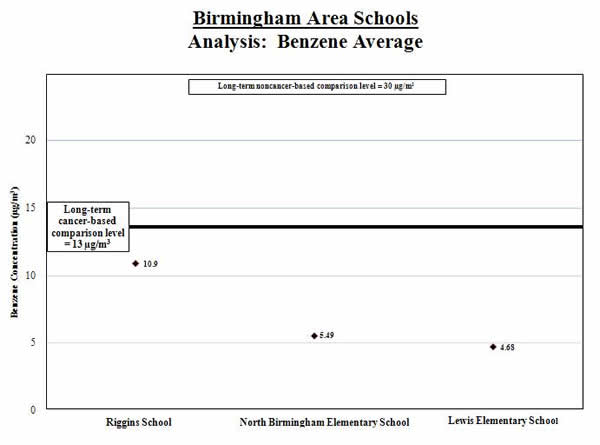
1b. Calculate a range for the benzene average: To account for varying air concentrations of benzene, we calculated a range around the average by estimating high and low values that the longer-term concentrations might reach using common statistical tools. We compared the highest point in the range (called the “upper bound”) to the long-term comparison levels.
Result: The high end of the range is higher than the comparison level at Riggins School. There is a potential for levels of health concern for long-term continuous exposure in the community near this school. At North Birmingham Elementary School and Lewis Elementary, the high ends of the benzene ranges were below the long-term comparison levels
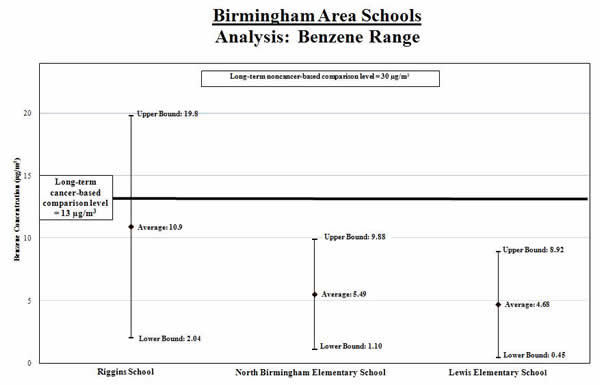
2a. Calculate the arsenic average: We calculated the average of the arsenic measurements (shown by the black diamond in the graph below). We compared this average to the long-term comparison level (thick line on the graph below).
Result: The average arsenic level for the samples collected at all three schools were well below the long-term comparison level.
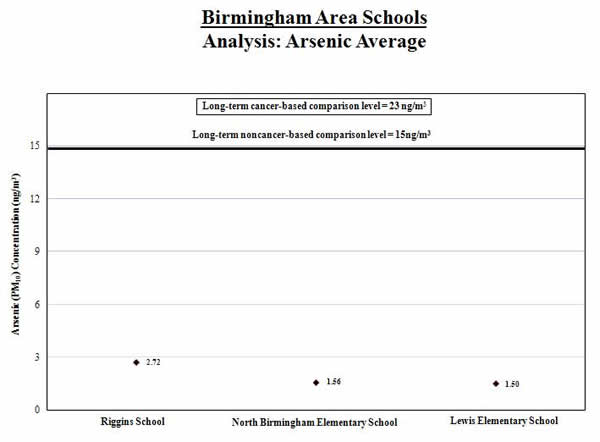
2b. Calculate a range for the arsenic average: To account for varying air concentrations of arsenic, we calculated a range around the average by estimating high and low values that the longer-term concentrations might reach using common statistical tools. We compared the highest point in the range (called the “upper bound”) to the long-term comparison level.
Result: The high ends of the ranges for all three schools are lower than the long-term comparison level.

3a. Calculate the benzo(a)pyrene average: We calculated the average of the benzo(a)pyrene measurements (shown by the black diamond in the graph below). We compared this average to the long-term comparison level (thick line on the graph below).
Result: The average benzo(a)pyrene level for the samples collected at all three schools were well below the long-term comparison level.
pyreneaverage.jpg)
3b. Calculate a range for the benzo(a)pyrene average: To account for varying air concentrations of benzo(a)pyrene, we calculated a range around the average by estimating high and low values that the longer-term concentrations might reach using common statistical tools. We compared the highest point in the range (called the “upper bound”) to the long-term comparison level.
Result: The high ends of the ranges for all three schools are lower than the comparison level.
pyrenerange.jpg)
Analysis of Measured Manganese Concentrations:
1. Calculate the average: We calculated the average of the manganese measurements (shown by the black diamond in the graph below). We compared this average to the long-term comparison level (thick line on the graph below). The long-term comparison level represents the level of manganese in the air that is below levels associated with health concerns, even if someone breathed air containing manganese at that level all day, every day over his/her lifetime.
Result: The average manganese level for the samples collected at Lewis Elementary School was slightly below the long-term comparison level. At Riggins School and North Birmingham Elementary School, the average manganese level for the samples collected was well below the long-term comparison level.

2. Calculate a range: To account for varying air concentrations of manganese, we calculated a range around the average. We did this by estimating high and low values that the longer-term concentrations might reach using common statistical tools. We compared the highest point in the range (called the “upper bound”) to the long-term comparison level.
Result: For Lewis Elementary School, the high end of the range is slightly higher than the comparison level. There is a potential for levels of health concern for long-term continuous exposure in areas closer to sources where concentrations are higher. At Riggins School and North Birmingham Elementary School, the high end of the manganese range was well below the long-term comparison level.
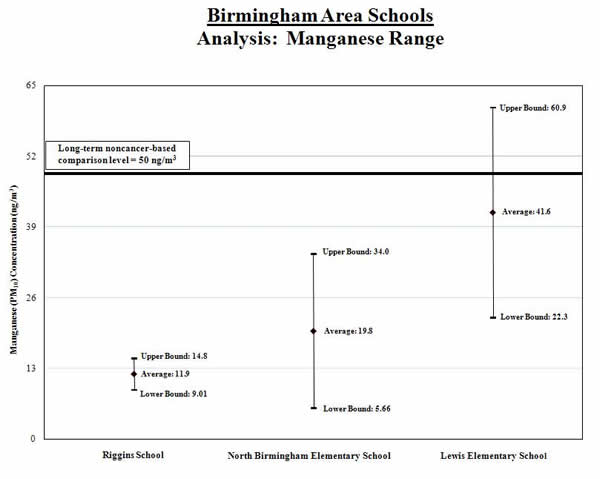
Analysis of Measured Wind Direction and Wind Speed at Each School
We took measurements of wind direction and speed every day during the sample period. We took special note of the wind speed and direction on the days we took measurements of lead, benzene, arsenic, benzo(a)pyrene, and manganese.
| What we looked at | What we found |
| We looked at whether the wind data taken on the days we took measurements of lead, benzene, arsenic, benzo(a)pyrene, and manganese were similar or different from the wind patterns during the entire sampling period. | We found the wind patterns taken on the days we took measurements of lead, benzene, arsenic, benzo(a)pyrene, and manganese to be generally similar to those observed during the entire sampling period with some exceptions, depending on the school. |
| We looked at whether the wind pattern during the sampling period was reflective of the regional wind pattern over the long term. | Although we lack long-term wind data at the monitoring sites, the wind pattern at the NWS station during the sampling period shares some similarities with the historical long-term wind flow pattern at that same NWS station. |
Analysis of Information on Nearby Sources of Lead, Benzene, Arsenic, Benzo(a)pyrene, and Manganese Emissions
| What we looked at | What we found |
| Whether we could determine if the sources were operating as usual during the sampling period. | Information from the nearby coke plants indicates that during the 2009 monitoring period, they were operating at about 60% of the 2008 and 2010 levels. However, it should be noted that pollutant emissions are not necessarily related to production levels at these coke plants. There are several sources of lead in the area, two of which are closed or not emitting lead. The electric arc furnace was operating at about half normal production levels, and another source’s production fell over 20% in 2009. It was determined that the chemical distribution facility only distributed chemicals and did not produce them. |
At all three schools, levels of lead, a pollutant for which there are national standards for ambient air, are below the level of the national standard for protection of public health. Our analysis also found that levels of a number of pollutants, some of which are associated with coke plant emissions, including benzene, arsenic, and benzo(a)pyrene, indicate a potential for levels of concern for long-term continuous exposure particularly in areas of the community close to the source of emissions. Levels of manganese in the air at Lewis Elementary School indicate a potential for levels of concern for long-term continuous exposure in areas closer to the source. The elevated level of manganese, while not indicating a level of concern for health effects at this location, indicates a potential for levels of concern in areas closer to the source. Levels of manganese in the air at the two other schools were below levels of concern. |
|
| The nearby sources of lead, benzene, arsenic, benzo(a)pyrene, and manganese have Title V operating air permits issued by JCHD that include operating requirements. |
Additional Information
Technical Report for School: Assessing Outdoor Air Near Schools: Riggins School, North Birmingham Elementary School, and Lewis Elementary School (Birmingham, AL) (PDF) (54pp, 1.1 MB). The technical report is geared toward risk assessors, risk managers, and other regulatory agencies.
Background on School Monitoring Effort
General Questions and Answers for School Monitoring Effort
